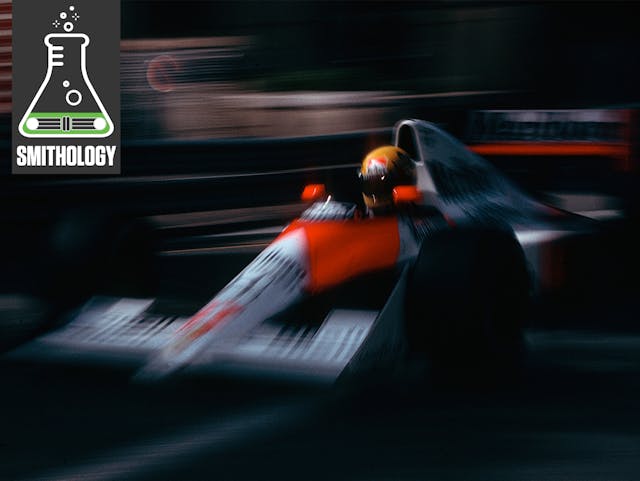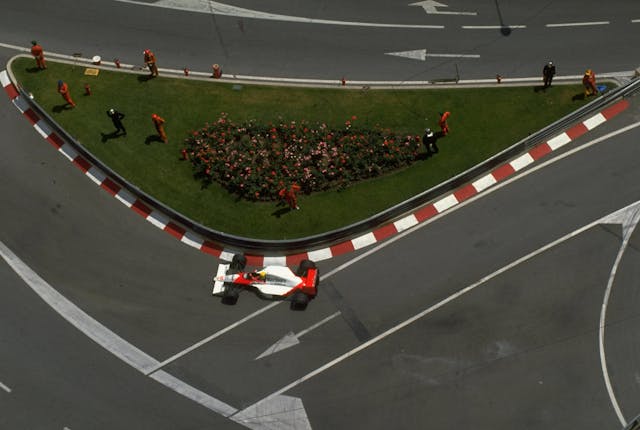Smithology: High redefinition

Have something you should watch, if you have a minute.
In May of 1990, Ayrton Senna was under contract with McLaren-Honda. The 30-year-old Brazilian was then nothing less than an international star, one of the most dazzling talents Formula 1 had ever seen. At that point, six years after entering motorsport’s highest echelon, he possessed just one of his three eventual championships but had already seized the sport’s all-time record for most pole positions. In an era where Formula 1 grids were particularly fierce, those numbers represent a kind of domination, or at least as close as one can get in a pastime hung on both human and machine. The sport that Senna came to define would eventually consume him—he died in a gruesome crash at Imola in 1994—but in the late 1980s and early 1990s, the man was a genuine legend in his own time, a brilliant spark at the peak of his powers.
Blame Twitter for the fact that he popped into my head recently. Shortly before Christmas, a British journalist named Liam Freeman tweeted out his 60-frames-per-second edit of a Senna lap at Monaco in 1990. The original clip that Freeman edited is a well-traveled and somewhat famous gem. It shows the man on a flyer in difficult quarters, up on plane and skittering through a winnowing street circuit that resembles at best a tight mountain pass and at worst an indifferently paved sidewalk. Senna ruled Monaco that year, starting from pole and notching fastest lap while leading all 78 laps of the race and winning. A big deal even then, and no small credit to his car, but also just the sort of thing the man was wont to do.

I first saw the lap clip in question more than 20 years ago on a fuzzy, static-filled VHS bootleg. This is what you did, in the days before YouTube, as an F1 goon in America—you obsessed and dug up illegal footage, and you watched the hell out of what little coverage made its way to the country’s TV networks every third blue moon. In the middle of all that, you read the books and the Autocourse annuals and Road & Track or Autoweek relentlessly, and you tried to think about what it would be like to live in a place where the bars all showed road racing every Sunday and every kid at school knew how to spell names like Tyrrell and Raidillon.
I was never much into sports, as Paul Newman said, and I dance like an elephant; racing was how I found grace.
Man, am I a dork who has watched a lot of onboards.
Freeman’s version of that Senna lap is magnificent. Before we get to how, though, take a moment to watch the original. As it sits on the official Formula 1 YouTube account, with just over four million views:
Hell of a thing, right? Lightning in a bottle. A raw, over-the-shoulder witness a channeled ferocity and the sort of desperate war-calm you only find in the cockpit of a race car on the edge.
It is no longer 1990, and while Formula 1 has grown faster, it has also become inarguably less compelling. Too much polish in the wrong places, and the cars sound like blenders. (What B-grade marketing dink decided that a globally popular spectacle needed less… spectacle?) If we are lucky, things will come back around; as with anything purportedly balancing both tradition and progress, F1 runs in peaks and valleys.
UPDATE, JANUARY 2021: Apologies. You might now expect me to show you Freeman’s edited version of that video. And I did, once—when this column was first written, the tweet containing his work was still live. That tweet has now been taken down, a result of F1’s oft-draconian approach to copyright infringement.
If I were king of the world, Freeman’s edited clip would be legal on grounds of fair use and teaching/research. But in lieu of that, we’ll use a similar edit of another piece of period footage.
Below, Jim Clark at the Brands Hatch in 1964. Watch at least a few seconds:
Now imagine the Senna footage edited similarly, and forgive us for no longer being able to share it here.
The edited clip is remarkable. And different. Also the same. Compelling, either way, though.
I can’t watch the new one.
Four days after it was uploaded to Twitter, Freeman’s Senna edit had garnered some 600,000 views. His work smoothed the clip to 60 frames per second, filling tiny but perceptible gaps, and noticeably clarified the audio. Many of the disorienting video artifacts were gone, and the footage was sharper and richer in contrast. The result was a clearer and far more accurate document of a unique man and a small automobile caught in a lightly improvised but highly structured ballet across public road and the intoxicating edge of control.
Monaco as F1 uses it is a street circuit, closed-off public roads bridged into a lap. More than a few drivers have noted that running a truly fast car there is akin to flying a fighter jet in your living room. Close quarters mean you don’t so much assemble a Monaco pole as dissect the microns between barriers and figure out where you can risk another millimeter in a three-g corner. Men have thrown cars into the track’s famous tunnel only to have them shotgun out in pieces, and while it’s no longer possible for a nasty crash to leave you in the harbor, the track remains gloriously unforgiving.

All of which is to say that there is something special about a special man doing a special job in that special place. I have for years watched the original Senna clip and never thought much about why, but the Freeman edit made me look deeper. It both added to and subtracted from the original, and which end of that exchange you favor probably says something about the song in your spleen, as a friend once said. In a lot of ways, the blurrier, jumpier original seems more vibrant, more in tune with the lore of raw talent and difficult, edgy work, with the insanity of such a car on lumpy, sine-waving streets originally designed for horses. It represents a certain mystery, what we think of when we think of chasing tenths between buildings at triple digits while threading a seemingly infinite number of needles.

Neither clip is right or wrong, of course. That I lean toward the original is merely a matter of preference. One gives the manic feel of an idea, while the other presents clear-eyed reality. You see more in the latter and have more time to process events, and the car seems less jumpy, lacking the Heisenberg. It’s also fair to call me biased; a job in this business can give you a pretty good idea of how much abuse a street course can put into a stiff and relatively fragile open-wheel car, and how that kind of machine can feel like skillet mercury on even the smoothest of pavement. I am thus primed to find and prioritize honest feeling over the harshness of daylight. But the difference between the two clips shines a light on how the appeal of this sport so often lies in fuzzy logic.
Senna was a complex man. He was a devout believer in both God and situational ethics, and many of his choices at the wheel evinced a degree of moral flexibility that can present poorly in hindsight. But if you know anything at all about motorsport, you cannot watch him work without marveling at the alchemy—how he managed to be four or five steps ahead of the world where his compatriots mostly hung out at one or two. The pavement as canvas, not Lego instructions.

Wayne Gretzky saw the whole ice better than anyone else. Michael Jordan was occasionally able to send gravity packing. Alex Honnold views mountains as living objects apart from the rest of the world, and those mountains occasionally seem obliged to return the favor. We want our heroes to do things we obviously can’t. We want them to be like us but not too much so, relatable but also elevated, and the nature of that ask has always been strange. It mirrors what we request of celebrities or world leaders, both realistic and seemingly outside possibility. Except some people make it possible, and tame the beast.
I wonder occasionally what we think we’re doing, making motorsport seem less relatable in pursuit of speed and a de-beastified machine. Late in 2020, for an exhibition, Renault paired two-time world champion Fernando Alonso with the loud and fissile little 2005 car in which he won his first title. That machine was built to a ruleset predating today’s faster but obnoxiously large hybrids, and it circled the track in compellingly ear-piercing feints. The internet, which generally remembers nothing before yesterday, watched the 2005 car’s onboard, compared it to the current cars, and went predictably nuts. The current head of the Mercedes-AMG F1 team, a German named Toto Wolff, allowed that the Renault’s drama held lessons. The sport had strayed a little, he said. Pins were heard dropping everywhere as precisely nobody disagreed.
Like the Senna footage, that moment served as reminder that the How of an achievement is inevitably more compelling than the What. We want to see the best of us push themselves in ways we can’t or won’t, know what is possible when you remove every reasonable limitation and put clarity to blur. In that sense, anyone who brightens and focuses the past has done us a service, and I’m grateful.
And yet. We are currently at the tail of a deeply abnormal holiday season, after a long and wearing year. I find myself taking regular walks around town in the evenings, short daily stretches to turn my mind off, like staring into a fire or watching cockpit footage over and over. Which fits, really; fires are a lot like people and even more like film. Long after the light goes out, you remember not so much the specifics of their presence as how they made you feel. Just some warmth and glow and a bit of time, and a sensation distant from—but not entirely dissimilar to—magic.

